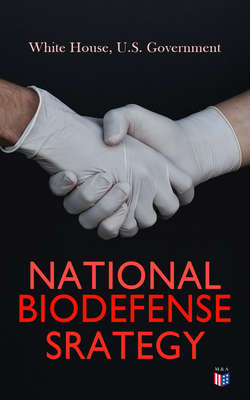Читать книгу National Biodefense Strategy - White House - Страница 9
Assumptions
ОглавлениеThe evolving biological threat landscape requires a comprehensive approach, and the United States recognizes the following principles:
Biological Threats are Persistent. Pathogens have emerged and spread throughout history, and as new naturally occurring threats develop, the risk from them grows more acute as the world becomes more urbanized, travel increases, and habitats change. Separately, nation-states and terrorist groups have found value in pursuing biological weapons, and there can be no confidence that will change in the future. Advances in the life sciences will both reduce the technological hurdles to such weapons and expand the number of individuals with relevant skills to effectuate threats.
Biological Threats Originate from Multiple Sources. The United States will include, within the scope of biodefense, not just countering deliberate biological threats, but also the threats that stem from naturally occurring and accidental outbreaks. This approach will allow the United States Government to fully utilize, integrate, and coordinate the biodefense enterprise and ensure the most efficient use of all biodefense assets.
Infectious Diseases Do Not Respect Borders. An interconnected world increases the opportunity for pathogens to emerge and spread so that a disease threat anywhere is a disease threat everywhere. Infectious diseases travel without visas and cross borders indiscriminately; infected travelers may not manifest any symptoms. The United States Government will mitigate biological incidents both here in the United States and work with partners abroad because the United States cannot counter biological threats nationally without addressing them internationally. We will also seek to improve our ability to prevent the spread of infectious diseases to the United States through inbound travelers and goods. The Ebola outbreaks of 2014 and 2018 demonstrated that the United States Government must be prepared to act swiftly, and unilaterally if necessary, to respond to public health emergencies abroad if multilateral institutions and partners are not prepared to do so.
Multi-sectoral Cooperation is Critical for Prevention and Response. This strategy calls for engagement and cooperation across all levels of government, to include SLTT governments, as well as internationally. It involves partnership with multiple sectors, including the medical; public, animal, and plant health; emergency response; scientific and technical; law enforcement; industrial; academic; diplomatic; defense and security; intelligence; and nonproliferation and counterproliferation sectors, among others. Engagement with non-governmental organizations (NGOs) and the private sector is critical to prevent the spread of disease and respond to the next outbreak before it becomes an epidemic.
A Multidisciplinary Approach Will Help Prevent Disease Emergence. The health of people, animals, plants, and the environment are linked, and diseases affecting one component can soon affect others. At least 75 percent of infectious disease threats to human health are of animal origin. Threats to animals and plants can cause economic disruption and physical harm to health and wellbeing. A coordinated, multidisciplinary approach, representing the collaborative efforts across local, national, and global jurisdictions, is a best practice for understanding, communicating, and mitigating biological threats swiftly and efficiently. Such an approach is necessary to prevent and detect early interspecies cross-over of infectious diseases.
Science and Technology Will Continue to Advance Globally. The ongoing revolution in the life sciences and biotechnology will continue at an ever-increasing rate, offering solutions to many of the challenges of ensuring the health, prosperity, and security of a growing global population. These technologies, no longer confined to sophisticated research laboratories, are being developed and utilized all over the world and the necessary expertise, materials, and equipment are available widely. Advances in science and technology bring revolutionary cures and progress, but they also have the potential to facilitate intentional misuse. The United States has a responsibility to ensure our technology, development, and assistance programs do not exacerbate this risk unintentionally.
